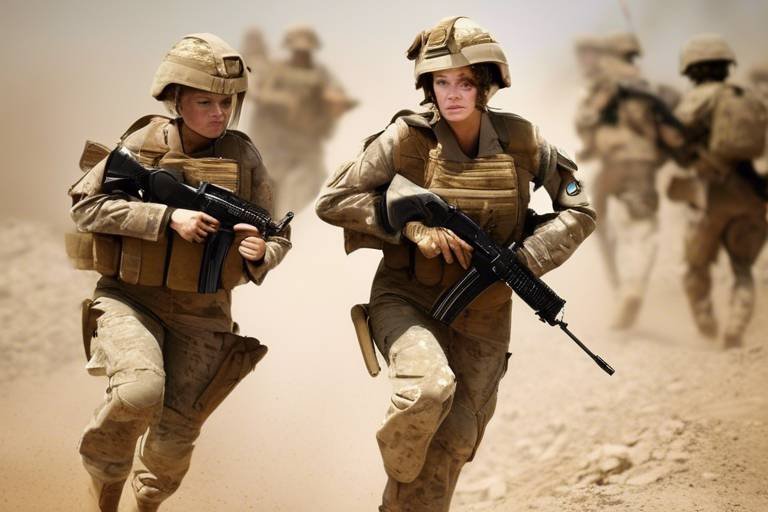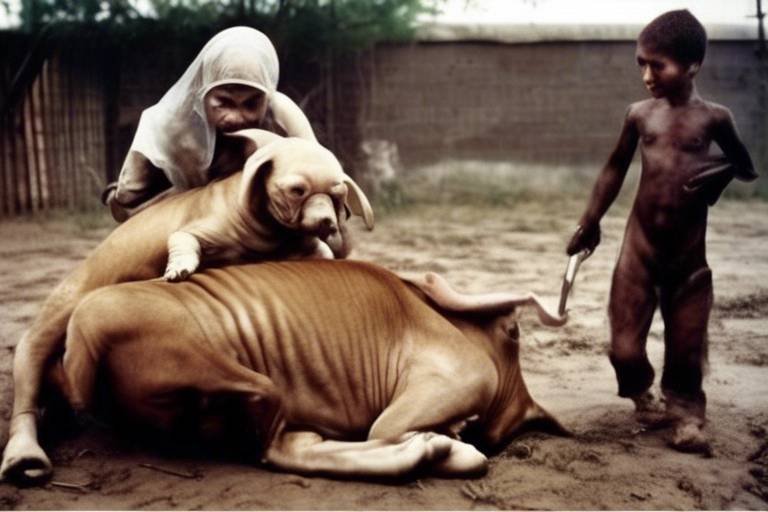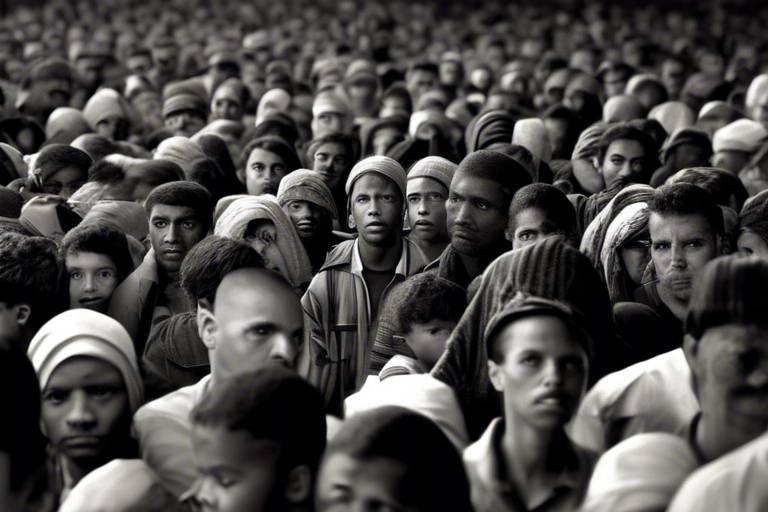Women in Combat - The Moral and Ethical Issues
Throughout history, the role of women in combat has been a topic of heated debate, filled with moral and ethical dilemmas. As societies evolve, so do their views on gender roles, particularly in high-stakes environments like the military. The question arises: should women be allowed to fight alongside men on the front lines? This inquiry is not merely about physical capability; it encompasses a myriad of factors, including societal perceptions, historical precedents, and the implications for military effectiveness and equality.
To understand the complexities of this issue, we must first acknowledge that women have participated in warfare for centuries, often in unofficial capacities. From the fierce warriors of ancient civilizations to the nurses and support staff in modern conflicts, their contributions have been significant yet frequently overlooked. As we delve deeper into this topic, it becomes clear that the moral and ethical considerations surrounding women in combat roles are not only about their abilities but also about the cultural narratives that shape our understanding of gender and warfare.
One of the most compelling arguments in favor of women serving in combat is rooted in the principle of equality. If women are capable of meeting the same physical and mental standards as their male counterparts, why should they be barred from combat roles? This perspective challenges traditional gender norms and advocates for a more inclusive military environment. However, the discussion is not one-sided; there are voices that raise concerns about unit cohesion, the psychological impacts of combat, and the potential for differing physical capabilities to affect overall military effectiveness.
Furthermore, the integration of women into combat roles prompts us to examine the ethical responsibilities of military institutions. Are they prepared to provide the necessary support systems for women who may face unique challenges in combat? The implications of this question extend beyond the battlefield, touching on issues of mental health, trauma, and resilience. It is essential to ensure that female combatants have access to adequate resources and support, recognizing that their experiences in combat may differ from those of their male peers.
As we explore the moral and ethical issues surrounding women in combat, it is crucial to consider the societal perceptions that influence public opinion. Cultural attitudes toward gender roles can significantly impact the acceptance of women in military positions. In many societies, traditional views still prevail, making it difficult for women to break through the barriers that have historically confined them to supportive roles. This societal backdrop adds another layer of complexity to the discussion, as advocates for gender equality must not only challenge military policies but also shift public perception.
In conclusion, the question of women in combat roles is multifaceted, encompassing historical, ethical, and societal dimensions. As we look to the future, it is vital to continue the conversation, addressing the challenges and opportunities that lie ahead. The integration of women into combat roles is not just a matter of policy; it reflects broader societal changes and the ongoing struggle for equality in all spheres of life.
- What historical roles have women played in combat? Women have served in various capacities, from warriors in ancient times to support roles in modern militaries.
- How do societal perceptions affect women's participation in combat? Cultural attitudes and traditional gender roles can create barriers for women seeking combat positions.
- What are the ethical implications of women in combat? The inclusion of women raises questions of equality, military effectiveness, and the responsibilities of military institutions.
- What psychological challenges do female combatants face? Female soldiers may encounter unique mental health challenges, including trauma and the need for tailored support systems.
- What does the future hold for women in combat roles? Ongoing discussions and advocacy efforts will shape the evolving landscape of gender inclusion in the military.

The Historical Context of Women in Combat
When we think about women in combat, our minds often drift to contemporary military forces, where women are increasingly taking on roles traditionally reserved for men. However, the reality is that women have been involved in warfare for centuries, albeit often in unofficial or auxiliary capacities. From the fierce Valkyries of Norse mythology to the courageous female soldiers in World War II, the contributions of women in combat have been both significant and varied.
Historically, women have been warriors, leaders, and strategists, although their roles have frequently been overlooked or minimized. In ancient societies, women participated in battles, sometimes leading troops or even commanding armies. For example, the legendary Joan of Arc played a pivotal role in the Hundred Years' War, inspiring French troops to victory against the English. Her story is just one of many that illustrate how women have defied societal norms to take up arms and fight for their countries.
As we move through history, the perception of women in combat has evolved dramatically. During the American Civil War, women disguised themselves as men to fight, with some even serving as spies or nurses on the front lines. Their contributions were vital, yet they often remained anonymous, their stories buried under the weight of history. It wasn't until the 20th century that women's roles in the military began to be recognized officially, particularly during the World Wars when women filled critical gaps in the workforce and military.
The post-war era saw a significant shift in societal attitudes towards women in combat. The feminist movements of the 1960s and 1970s challenged traditional gender roles, advocating for equality in all aspects of life, including the military. This push for equality led to changes in military policies, allowing women to serve in more diverse roles. By the late 20th century, women were not only serving in support roles but also in combat positions, albeit under strict regulations.
Today, the inclusion of women in combat roles is not just a matter of policy but also one of moral and ethical consideration. The historical context provides a backdrop against which we can understand the ongoing debates surrounding women's participation in combat. As we explore these issues further, it's crucial to recognize the rich tapestry of women's contributions to warfare and the ongoing struggle for recognition and equality.
To illustrate the historical involvement of women in combat, the table below summarizes key milestones:
| Year | Event | Description |
|---|---|---|
| 1000s | Valkyries | Mythical female figures who chose those who may die or live in battles. |
| 1429 | Joan of Arc | Led French troops to victory during the Hundred Years' War. |
| 1861-1865 | American Civil War | Women disguised as men fought and served as nurses and spies. |
| 1917-1918 | World War I | Women served in various roles, including nurses and support staff. |
| 1940s | World War II | Women served in combat and non-combat roles, including the WAC and WAVES. |
| 2013 | Combat Exclusion Policy Lifted | The U.S. military officially lifted the ban on women in combat roles. |
Understanding the historical context of women in combat not only highlights their significant contributions but also sets the stage for a deeper discussion on the moral and ethical implications of their involvement in modern warfare. As we continue to explore this topic, we must consider how these historical precedents inform current policies and societal attitudes towards women in the military.

Societal Perceptions and Gender Roles
When we think about women in combat, it’s impossible to ignore the heavy influence of societal perceptions and entrenched gender roles that have shaped our views over centuries. Historically, combat has been viewed as a domain reserved for men, with the image of a soldier often conjuring up a rugged male figure. This stereotype is deeply embedded in our culture, stemming from traditional beliefs about masculinity and femininity. But as we push forward into a more equal society, these perceptions are being challenged, leading to a fascinating evolution in how we view women's roles in the military.
Let’s take a moment to reflect on how these societal views impact women seeking combat roles. Many women face skepticism and resistance, not just from their peers but also from within the military establishment itself. The stigma surrounding female soldiers can manifest in various ways, from doubts about their physical capabilities to concerns about unit cohesion. It raises an important question: Are these perceptions based on facts, or are they simply outdated stereotypes?
To understand this better, we can look at how societal attitudes have shifted over time. In the past, women were often relegated to supportive roles, such as nurses or administrators, during wartime. However, as women began to prove their capabilities in various fields, including military operations, the narrative started to change. Today, women serve in combat roles in numerous countries, demonstrating that they can perform just as effectively as their male counterparts. This shift has been bolstered by media representation, showcasing female soldiers in action and challenging traditional norms.
Moreover, the conversation around gender roles isn't just about women proving themselves; it's also about men's perceptions of women's capabilities. Many men have been raised with the belief that combat is inherently a male domain, which can lead to resistance against women in these roles. However, research indicates that diverse teams, including both men and women, often outperform homogeneous groups. This suggests that breaking down gender barriers can lead to improved military effectiveness and better outcomes in combat situations.
While societal perceptions are slowly evolving, there’s still a long way to go. Women in combat roles often find themselves having to navigate a complex landscape of expectations and stereotypes. They must continually prove their worth in environments that may not always be welcoming. This reality can be both a source of motivation and a significant burden. The challenge lies in not only changing minds but also in creating an environment where women can thrive without the weight of societal expectations holding them back.
In conclusion, the journey towards acceptance of women in combat is fraught with challenges, but it is also filled with opportunities for growth and change. As society continues to evolve, we must ask ourselves: How can we support this transformation? It will take collective effort—through education, advocacy, and open dialogue—to dismantle the barriers that persist and foster a more inclusive military culture.
- What are the main challenges women face in combat roles? Women often encounter skepticism regarding their abilities, face unique psychological challenges, and must navigate a male-dominated culture.
- How have societal perceptions of women in combat changed over time? While historically viewed as unsuitable for combat, increasing visibility and success of women in military roles have begun to shift these perceptions.
- What impact does gender diversity have on military effectiveness? Research shows that diverse teams can enhance performance and decision-making, leading to better outcomes in combat situations.
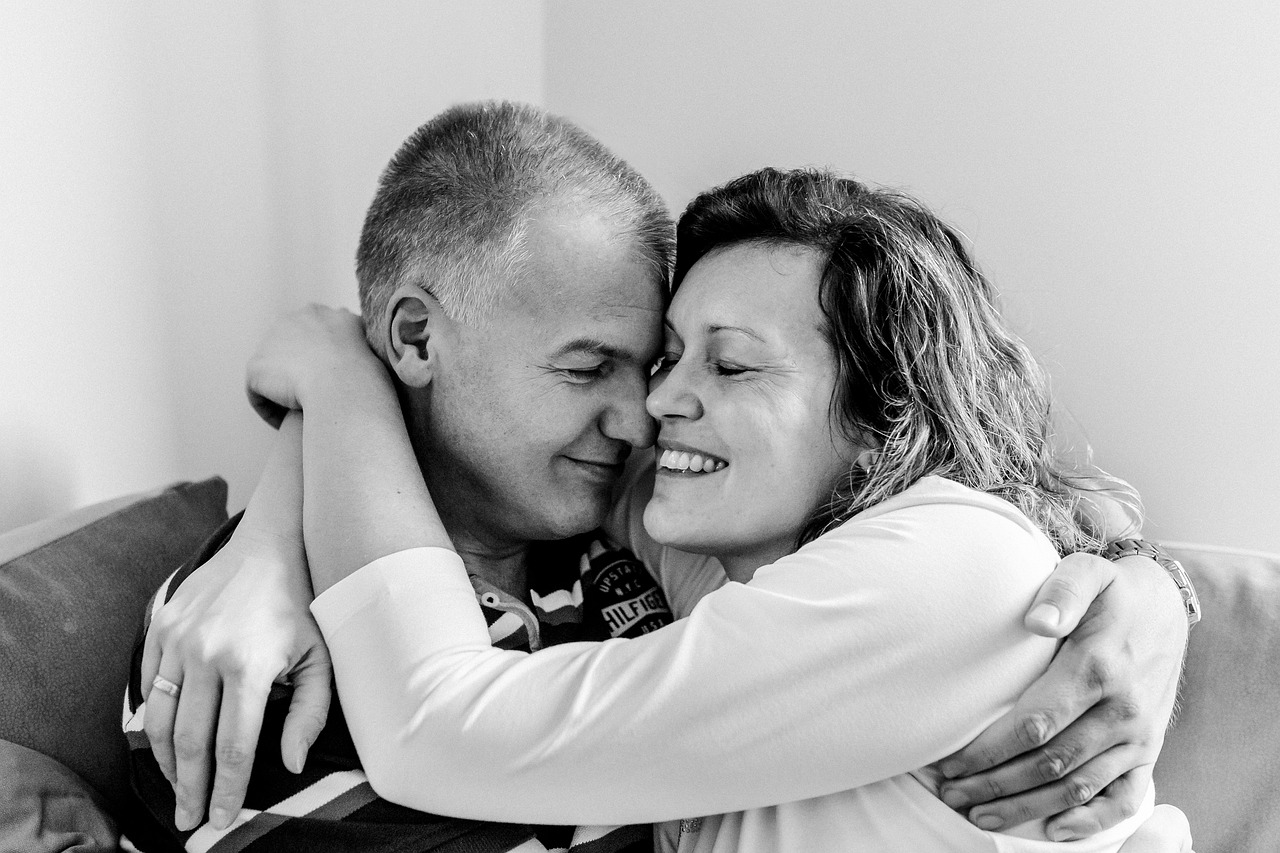
Legal and Policy Frameworks
The legal landscape surrounding women in combat roles has undergone a significant transformation over the past several decades. Historically, women were largely excluded from direct combat positions due to prevailing societal norms and military policies that deemed them unsuitable for such roles. However, as the understanding of gender equality has evolved, so too have the laws and regulations governing women's participation in the military.
In the early 1990s, the U.S. military began to reassess its policies regarding women in combat, particularly during the Gulf War, where female service members demonstrated their capabilities in various support roles. This led to a gradual shift in policy, culminating in the 2013 decision by the U.S. Department of Defense to officially lift the ban on women serving in combat positions. This pivotal moment marked a significant milestone in the fight for gender equality within the military, allowing women to serve in roles that had previously been denied to them.
Despite these advancements, challenges remain. Many military branches have implemented specific policies to ensure that women are integrated into combat roles effectively. For instance, the Army's integration plan includes measures to support female soldiers, such as tailored training programs and mentorship opportunities. However, the implementation of these policies varies across different branches and units, leading to inconsistencies in how women are treated and supported in combat environments.
Moreover, the legal frameworks surrounding women's participation in combat are often influenced by broader societal attitudes toward gender roles. In many cultures, traditional views on masculinity and femininity continue to shape perceptions about women's capabilities in high-stress, physically demanding situations. As a result, legal and policy frameworks must not only address the technical aspects of integration but also the cultural barriers that persist.
To better understand the current legal frameworks, let’s take a look at some key policies that have shaped women's roles in combat:
| Year | Policy/Change | Description |
|---|---|---|
| 1994 | Direct Combat Exclusion Rule | This policy restricted women from serving in direct combat roles but allowed them to participate in support roles. |
| 2013 | Lift of Combat Ban | The Department of Defense officially lifted the ban on women serving in combat positions, paving the way for their full integration. |
| 2016 | Implementation of Gender Integration Policies | Military branches began developing specific strategies to integrate women into combat roles effectively. |
As we look to the future, the ongoing debates surrounding women's roles in combat will likely continue to evolve. Advocacy groups have emerged to support the rights of female soldiers, pushing for more inclusive policies and greater recognition of their contributions. These groups argue that the integration of women in combat not only promotes equality but also enhances military effectiveness by leveraging diverse perspectives and skills.
In conclusion, the legal and policy frameworks governing women in combat are complex and multifaceted. As society continues to challenge traditional gender norms, it is crucial for military institutions to adapt and evolve their policies to ensure that all service members, regardless of gender, have the opportunity to serve in combat roles. Ultimately, fostering an inclusive environment not only benefits individual soldiers but also strengthens the overall effectiveness of the military as a whole.
- What are the current policies regarding women in combat roles? - The policies have evolved significantly, with the U.S. Department of Defense lifting the ban on women in combat roles in 2013, allowing for full integration.
- Are there any ongoing debates about women serving in combat? - Yes, there are ongoing discussions about the effectiveness and implications of women in combat, including issues of unit cohesion and performance.
- What challenges do women face in combat roles? - Women often encounter cultural barriers, unequal treatment, and the need for tailored support systems in combat environments.

Military Effectiveness and Cohesion
When discussing the integration of women into combat roles, one of the most frequently raised concerns is the impact on military effectiveness and unit cohesion. Critics often argue that introducing women into combat units could disrupt the tightly knit bonds that are essential for operational success. However, research and real-world experiences tell a different story. Many studies indicate that gender diversity can actually enhance unit performance, bringing a wealth of perspectives and problem-solving approaches that can lead to better outcomes on the battlefield.
Consider this: a team that embodies a range of backgrounds and experiences can tackle challenges more creatively. Just like a sports team thrives on the unique strengths of its players, a military unit can benefit from the diverse skills that both men and women bring to the table. In fact, a study conducted by the U.S. Army Research Institute found that mixed-gender teams often outperformed all-male teams in various tasks. This suggests that the inclusion of women can not only maintain but potentially enhance military effectiveness.
Moreover, the notion of cohesion is evolving. Traditionally, cohesion has been viewed through a lens of homogeneity, where shared experiences and backgrounds foster strong bonds. Yet, as society progresses, the military is learning that cohesion can also be built on mutual respect, trust, and shared goals, regardless of gender. In fact, units that embrace diversity often report higher morale and lower instances of conflict, which are crucial for operational success.
To illustrate this point, let's look at a table summarizing key findings from various studies on military effectiveness and gender integration:
| Study | Findings |
|---|---|
| U.S. Army Research Institute | Mixed-gender teams outperformed all-male teams in performance tasks. |
| Marine Corps Study | Integration led to improved problem-solving and adaptability in diverse units. |
| Defense Department Report | Units with women reported higher morale and better communication. |
However, it's essential to acknowledge that challenges remain. Some argue that physical differences could affect performance in certain combat scenarios. While it’s true that physiological differences exist, the military has already adapted training and standards to ensure that all personnel, regardless of gender, meet the necessary requirements. The focus should be on capability rather than gender; after all, a soldier's effectiveness is determined by their skills, training, and mindset, not just their physical attributes.
In conclusion, the integration of women into combat roles is not just a matter of fairness or equality; it is a strategic decision that can enhance military effectiveness and cohesion. As we move forward, embracing diversity in the ranks will not only reflect the society we serve but also strengthen our military forces, making them more adaptable and resilient in the face of modern challenges.
- What are the benefits of including women in combat roles?
Including women in combat roles can enhance team performance, improve problem-solving, and increase overall military effectiveness. - How does gender diversity affect unit cohesion?
Gender diversity can foster mutual respect and trust, leading to stronger bonds within units, even amidst differing backgrounds. - Are there specific studies supporting women's integration in combat?
Yes, numerous studies, including those from the U.S. Army Research Institute, indicate that mixed-gender teams often outperform all-male teams. - What challenges do women face in combat roles?
Women may encounter physical challenges, societal biases, and the need to prove their capabilities in a traditionally male-dominated environment.

Ethical Considerations and Equality
The discussion surrounding women's participation in combat roles is not just a matter of capability; it delves deep into ethical considerations and the quest for equality. At the heart of this debate lies the fundamental question: should women have the same opportunities as men in all military roles? Advocates for gender equality argue that excluding women from combat positions is a form of discrimination that undermines their rights and capabilities. This perspective is rooted in the belief that all individuals, regardless of gender, should have the opportunity to serve their country in any capacity they choose.
On the other hand, some argue that the unique physical demands of combat roles may require a different standard of assessment. They often cite concerns about unit cohesion and the potential impact of mixed-gender teams on overall military effectiveness. However, it’s crucial to consider that these arguments often stem from traditional views on gender roles rather than empirical evidence. Studies have shown that diverse teams can enhance performance and innovation, suggesting that gender inclusion might actually strengthen military units rather than weaken them.
Additionally, the ethical implications extend beyond mere participation. They encompass the treatment of female soldiers once they are in combat roles. Are they given the same respect and support as their male counterparts? Are they provided with adequate resources to handle the unique challenges they face? The military must ensure that all soldiers, regardless of gender, are treated equitably and have access to the same opportunities for advancement and recognition.
Moreover, the moral responsibilities of military institutions cannot be overlooked. They must actively work to dismantle any existing barriers that prevent women from serving in combat roles. This involves not only policy changes but also a cultural shift within the military that embraces diversity and equality. For instance, mentorship programs aimed at supporting female soldiers can play a significant role in fostering an inclusive environment. By promoting female leadership within the ranks, the military can challenge stereotypes and encourage more women to pursue combat roles.
In conclusion, the ethical considerations surrounding women in combat are complex and multifaceted. While there are valid concerns regarding physical demands and unit cohesion, these should not overshadow the fundamental rights to equality and opportunity. As society evolves, so too must our perceptions and policies regarding gender in the military. The path to true equality involves recognizing the capabilities of all individuals and ensuring that everyone has the chance to contribute to national defense, regardless of gender.
- What are the main arguments for including women in combat roles?
Proponents argue that it promotes equality, utilizes the full range of talent available, and enhances team diversity, which can lead to improved problem-solving and innovation.
- Are there any studies that support the effectiveness of mixed-gender combat units?
Yes, various studies indicate that diverse teams can perform as well as, if not better than, homogenous teams, particularly in complex environments where different perspectives are beneficial.
- What challenges do female soldiers face in combat?
Women in combat may encounter unique psychological and physical challenges, including societal biases, potential harassment, and the need for tailored support systems.
- How can the military support female combatants?
Through mentorship programs, equal opportunity policies, and ensuring access to mental health resources, the military can create a more inclusive environment for female soldiers.

Psychological Impacts on Female Combatants
The journey of women in combat roles is not just paved with physical challenges; it is also fraught with profound psychological impacts. Female combatants often face unique mental health challenges that can stem from the dual pressures of their combat duties and societal expectations. Imagine being in a high-stress environment where every decision can mean the difference between life and death, while also grappling with the stigma that comes from being a woman in a traditionally male-dominated space. This duality can lead to a complex array of psychological responses.
One of the most significant aspects of the psychological impact on female soldiers is the prevalence of post-traumatic stress disorder (PTSD). Research indicates that women in combat may experience PTSD at rates comparable to their male counterparts, but their symptoms can manifest differently. Women are often more likely to internalize their trauma, leading to issues such as depression and anxiety. They might also face societal pressures that discourage them from expressing vulnerability, creating a cycle of silence and suffering. This leads us to the importance of understanding the specific needs of female combatants when it comes to mental health support.
Moreover, the stigma surrounding mental health issues can be particularly pronounced for women in the military. Many female soldiers report feeling that they must prove their toughness, which can prevent them from seeking help. This culture of silence can exacerbate feelings of isolation and despair. The military's traditional approach to mental health has often overlooked the unique experiences of women, making it essential to develop targeted support systems. The following are some common psychological challenges faced by female combatants:
- Isolation: Many women feel isolated from their peers, both during and after deployment. This can stem from a lack of understanding from male colleagues or the feeling of being an outsider in a male-dominated environment.
- Identity Conflict: Female soldiers may struggle with balancing their military identity with societal expectations of femininity, leading to internal conflicts that can affect their mental well-being.
- Fear of Judgment: The fear of being judged by peers or superiors for expressing emotional distress can deter women from seeking necessary support.
In response to these challenges, many military organizations are beginning to implement programs specifically designed to address the mental health needs of female soldiers. These initiatives often focus on creating safe spaces for women to share their experiences and seek help without fear of stigma. Additionally, peer support programs have proven effective in fostering a sense of community among female combatants, allowing them to connect and share coping strategies.
Furthermore, the role of resilience cannot be overlooked. Many female combatants demonstrate remarkable resilience, often drawing on their experiences and support networks to navigate the challenges they face. Understanding the factors that contribute to resilience in female soldiers can provide valuable insights into effective mental health interventions. This might include training programs that emphasize coping strategies, stress management, and the importance of seeking help when needed.
As we move forward, it is crucial to continue addressing the psychological impacts on female combatants. The military must evolve to recognize and support the unique experiences of women in combat roles. By fostering an environment that prioritizes mental health and encourages open dialogue, we can ensure that female soldiers receive the support they need to thrive both on and off the battlefield.
- What are the common psychological issues faced by female combatants? Female combatants often experience PTSD, anxiety, depression, and feelings of isolation.
- How does stigma affect female soldiers seeking mental health support? Stigma can prevent women from expressing their struggles or seeking help, leading to increased feelings of isolation and mental distress.
- What kind of support systems are available for female combatants? Many military organizations are developing targeted mental health programs, peer support groups, and safe spaces for women to share their experiences.

Case Studies and Real-Life Experiences
When it comes to understanding the complex landscape of women in combat, real-life experiences and case studies serve as powerful narratives that highlight the challenges and triumphs of female soldiers. One notable example is the story of Captain Linda M. McGowan, who served in the U.S. Army during a deployment in Iraq. Captain McGowan faced not only the physical demands of combat but also the psychological hurdles of being in a male-dominated environment. Her journey sheds light on the resilience that many women in combat exhibit, as well as the prejudices they must navigate.
In her own words, Captain McGowan stated, “Every day was a battle—not just against the enemy but against the stereotypes that I was not capable of leading a unit in combat.” This sentiment resonates with many female combatants who often find themselves needing to prove their worth in a field that has historically sidelined them. Her experience illustrates the dual battle of fighting for one's country while simultaneously fighting for acceptance and respect within the ranks.
Another compelling case is that of Sergeant First Class Anna Johnson, who served as a medic in Afghanistan. Johnson's role was critical, as she not only provided medical care under fire but also served as a bridge between male soldiers and local women, who might otherwise refuse care from male medics. Through her service, Johnson demonstrated that women in combat can bring unique perspectives and skills that enhance mission effectiveness. Her story is a testament to the diverse roles that women can fulfill in combat situations, challenging traditional notions of what it means to be a soldier.
Moreover, the experiences of these women are not isolated. According to a 2019 study by the Military Women’s Coalition, 75% of female veterans reported feeling a sense of pride in their combat service, despite facing significant barriers. This study further emphasizes the importance of sharing these stories, as they contribute to a broader understanding of the capabilities and contributions of women in the military.
To illustrate the impact of these experiences, we can look at a
| Name | Role | Deployment Location | Key Contribution |
|---|---|---|---|
| Captain Linda M. McGowan | Infantry Officer | Iraq | Leadership in combat and breaking stereotypes |
| Sergeant First Class Anna Johnson | Combat Medic | Afghanistan | Provided critical medical care and cultural liaison |
| Major Sarah Thompson | Logistics Officer | Kuwait | Improved supply chain efficiency for deployed units |
These stories are not just statistics; they are personal accounts of courage, determination, and the quest for equality in a challenging environment. As we look to the future, it is essential to continue amplifying these voices, ensuring that the contributions of women in combat are recognized and valued.
As we delve deeper into the narratives of women in combat, it becomes clear that their experiences not only shape their identities but also influence the perceptions of future generations regarding gender roles in the military. These case studies serve as a reminder that the fight for equality is ongoing, and the stories of these brave women are crucial in paving the way for a more inclusive military.
- What are the main challenges faced by women in combat? Women in combat often face challenges such as gender bias, physical demands, and the need to prove their capabilities in a male-dominated environment.
- How do women contribute to military effectiveness? Women bring diverse perspectives, skills, and experiences that enhance teamwork, communication, and cultural understanding in combat situations.
- What policies have changed regarding women in combat roles? Over the years, policies have evolved to allow women to serve in combat positions, with significant legislative changes occurring in the last decade.
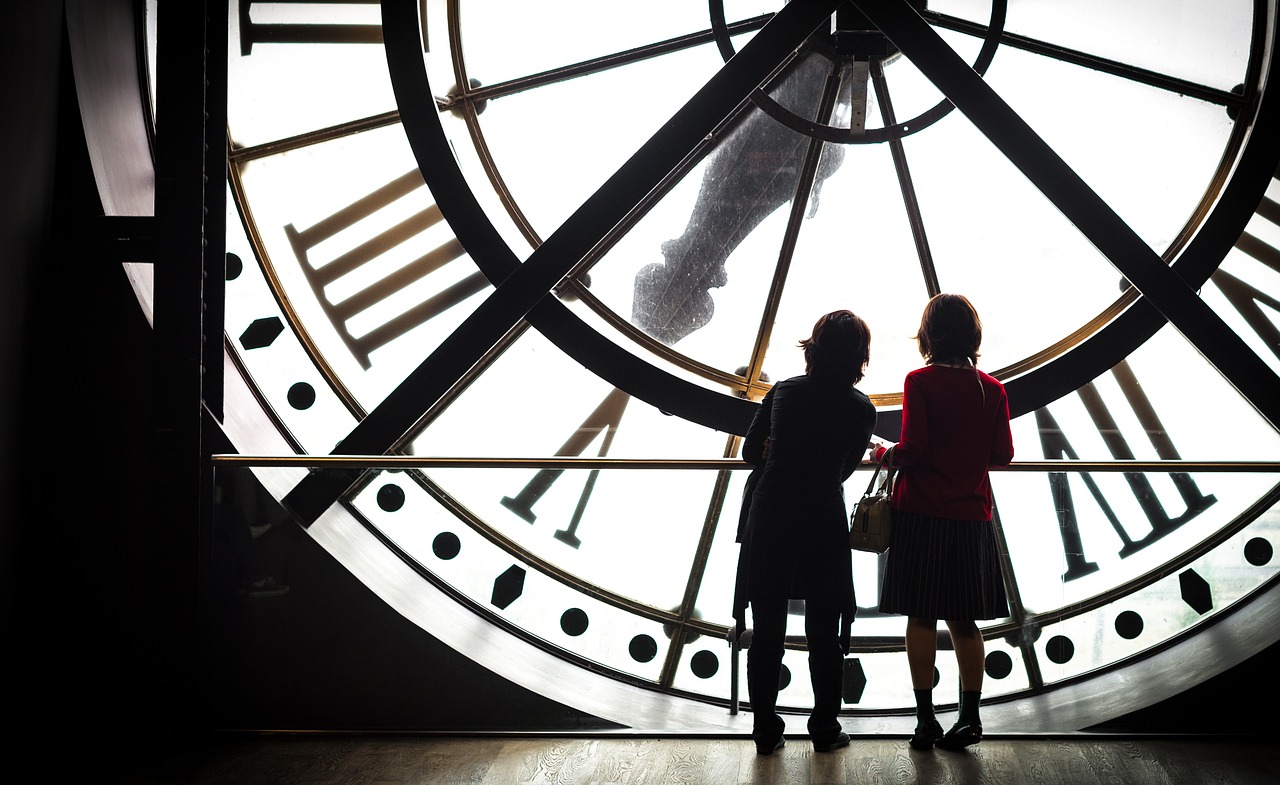
The Future of Women in Combat Roles
As we look toward the horizon, the future of women in combat roles appears both promising and challenging. The landscape is shifting, driven by changing societal norms, evolving military policies, and the relentless pursuit of equality. But what does this really mean for women who aspire to serve on the front lines? Are we ready to embrace a new era where gender no longer defines capability? Let's dive deeper into these questions.
In recent years, we've witnessed significant strides toward inclusivity in military settings. Women have increasingly been allowed to serve in various combat positions, breaking barriers that were once thought insurmountable. This change is not just a matter of policy; it reflects a broader cultural shift towards recognizing the invaluable contributions of women in all sectors, including the military. However, despite these advancements, challenges remain. The integration of women into combat roles has sparked debates about physical standards, unit cohesion, and the psychological impacts of combat on female soldiers.
Looking ahead, several factors will shape the future of women in combat roles:
- Advocacy and Policy Changes: Advocacy groups are vital in pushing for policies that support gender inclusion. Their efforts can lead to legislative changes that further open doors for women in combat.
- Training and Standards: Developing gender-neutral standards for combat readiness will be crucial. This ensures that all soldiers, regardless of gender, meet the same criteria, thereby emphasizing performance over gender.
- Public Perception: As societal attitudes continue to evolve, acceptance of women in combat roles is likely to grow. Education and awareness campaigns can help dismantle stereotypes that suggest women are less capable in combat situations.
Moreover, the military's commitment to diversity and inclusion will play a pivotal role in shaping the future. Studies have shown that diverse teams are often more effective, innovative, and resilient. By integrating women into combat roles, the military not only enhances its operational capabilities but also promotes a culture of equality and respect. This cultural shift can lead to improved morale and cohesion within units, fostering an environment where all soldiers feel valued and empowered.
Yet, it's essential to address the psychological aspects of integrating women into combat. Female soldiers may face unique challenges, including the pressure to prove themselves in a traditionally male-dominated environment. The military must prioritize mental health resources and support systems tailored specifically for women, ensuring they have access to the help they need to thrive in high-stress situations.
As we envision the future, it’s clear that the path forward is not without obstacles. However, with continued advocacy, policy reform, and a commitment to equality, the military can pave the way for a more inclusive environment. The question remains: will we rise to the occasion and embrace this change, or will we cling to outdated notions of gender roles? The answer lies in our collective willingness to challenge the status quo and champion the rights of all service members, regardless of gender.
1. What are the current policies regarding women in combat roles?
Policies vary by country and military branch, but many have begun to lift restrictions on women serving in combat positions, recognizing their capabilities and contributions.
2. How does gender diversity affect military effectiveness?
Research indicates that diverse teams often perform better due to varied perspectives and problem-solving approaches, enhancing overall military effectiveness.
3. What support systems are available for female combatants?
Many militaries are implementing support systems focusing on mental health resources, mentorship programs, and peer support networks to help female soldiers navigate the unique challenges they face.
4. Are there still barriers to women serving in combat?
Yes, despite progress, barriers such as societal perceptions, physical standards, and unit cohesion challenges remain, requiring ongoing efforts to address and overcome.
Frequently Asked Questions
- What historical roles have women played in combat?
Throughout history, women have participated in warfare in various capacities, often unofficially. From nurses and spies to warriors, their contributions have been significant, even if not always recognized. The perception of women in combat has evolved, reflecting changing societal norms and values.
- How do societal perceptions impact women in combat roles?
Societal views on gender roles greatly influence opinions about women in combat. Cultural attitudes can create barriers, making it challenging for women to gain acceptance in these roles. As society progresses, these perceptions are slowly changing, allowing for more inclusion and recognition of women's capabilities in combat.
- What legal changes have affected women in combat?
The legal landscape regarding women in combat has seen significant shifts over the years. Key policies and legislative changes have opened up combat roles to women, sparking ongoing debates about equality and military effectiveness. Understanding these changes is crucial to grasping the current state of women's involvement in the military.
- Does the inclusion of women affect military effectiveness?
Research indicates that gender diversity can positively impact military effectiveness and unit cohesion. Teams that include women often demonstrate improved performance and teamwork. However, the integration process can present challenges that need to be addressed to maximize the benefits of diversity.
- What are the ethical considerations surrounding women in combat?
The ethical implications of allowing women in combat roles are complex. Arguments for inclusion center on equality and rights, while concerns often focus on the physical demands of combat. Ultimately, military institutions have a moral responsibility to ensure that all personnel are treated fairly and given equal opportunities.
- What psychological challenges do female combatants face?
Women in combat encounter unique psychological challenges, including trauma and the pressure to perform in a male-dominated environment. Mental health support systems are crucial for helping female soldiers navigate these challenges and build resilience in the face of adversity.
- Can you share some real-life experiences of women in combat?
Real-life stories of women in combat provide invaluable insights into their experiences, challenges, and triumphs. These case studies highlight the personal and professional impact of their service, contributing to a broader understanding of gender dynamics within the military.
- What does the future hold for women in combat roles?
The future of women in combat roles is a topic of ongoing discussion, with potential developments and challenges on the horizon. Advocacy efforts play a vital role in shaping policies for gender inclusion, ensuring that women continue to have opportunities to serve in all capacities within the military.

